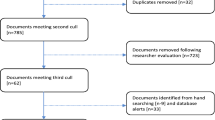Abstract
This article begins with a brief history of Dine College, the first tribally controlled college in the nation. I then provide an overview of Dine College’s educational philosophy, called Sa’ah Naaghai Bik’eh Hozhoon, and give examples that demonstrate how I apply this SNBH philosophy in my teaching. I discuss my own Dine identity, and explain how that fosters a greater understanding among the students I teach. I also introduce a concept called “the Navajo time bind” that illuminates the challenges I face in teaching sociology to a Navajo population. Overall, this article provides insights about the unique aspects of teaching sociology in a tribally controlled college.


Similar content being viewed by others
References
Ambler, M. (2002). “Thirty years strong.” Winter 2002. Tribal College Journal, 14(2).
Diné College Catalog. (2012–2013). Tsaile, Arizona: Diné College Press.
Harvard Project on American Indian Economic Development. (2008). The State of the NATIVE NATIONS: Conditions Under U.S. Policies of Self-Determination. Oxford: Oxford University Press.
Haskie, M. (2002). “Preserving the Navajo Culture: Practicing the Navajo Principles of Hozho doo K’e.” Ed.D. dissertation, School of Educational Leadership, Fielding Graduate University, Santa Barbara, CA.
Haskie, M. & Shreve, B. (2013). “Hozho Nahasdlii—finding harmony in the long shadow of colonialism: Two perspectives on teaching anti-racism at a tribal college.” In: K. Haltinner (Ed.), Teaching Race in Contemporary America. Springer Publishers.
Hochschild, A.R., (1997). The time bind: When work becomes home and home becomes work. New York: Metropolitan Books Henry Holt Books.
Rothman, R. A. (2005). Inequality and stratification: race, class and gender (5th ed.). Upper Saddle River: Prentice Hall.
U.S. Census Bureau. (2010). “The American Indian and Alaska Native Population: 2010 Census Briefs.” Washington, D.C: U.S. Census Bureau, Retrieved April 4, 2012. (http://www.census.gov/population/race).
Young, R., & Morgan, W. (1987). The Navajo language: a grammar and colloquial dictionary. Albuquerque: University of New Mexico Press.
Author information
Authors and Affiliations
Corresponding author
Rights and permissions
About this article
Cite this article
Haskie, M. Teaching Sociology at a Tribal College: Navajo Philosophy as a Pedagogy. Am Soc 44, 378–384 (2013). https://doi.org/10.1007/s12108-013-9188-3
Published:
Issue Date:
DOI: https://doi.org/10.1007/s12108-013-9188-3




